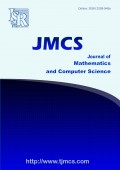Some New Mutation Operators for Genetic Data Clustering
-
2542
Downloads
-
3558
Views
Authors
Gholam Hasan Mohebpour
- Department of Computer Science, Payame Noor University, PO BOX 19395-3697, Tehran, Iran.
Arash Ghorbannia Delavar
- Department of Computer Science, Payame Noor University, PO BOX 19395-3697, Tehran, Iran.
Abstract
Genetic algorithm is one of evolutionary algorithms which have been used widely to solve many problems such as data clustering. There are lots of genetic data clustering algorithms which have worked on fitness function to improve the accuracy of algorithm in evaluation of generated chromosomes and have used simple and all purpose crossover and mutation operators such as one point crossover and random change mutation. Mutation process randomly modifies the gene values at selected locations to increase genetic diversity, by forcing the algorithm to search areas other than the current area. Simple non heuristic mutations such as random change mutation increase genetic diversity but they also increase execution time and decrease fitness of population. In this paper we introduce some new heuristic mutation operators for genetic data clustering. Experimental results show that all of proposed mutation operators creates better offspring than random change mutation and increases the fitness of population.
Share and Cite
ISRP Style
Gholam Hasan Mohebpour, Arash Ghorbannia Delavar, Some New Mutation Operators for Genetic Data Clustering, Journal of Mathematics and Computer Science, 12 (2014), no. 4, 282-294
AMA Style
Mohebpour Gholam Hasan, Delavar Arash Ghorbannia, Some New Mutation Operators for Genetic Data Clustering. J Math Comput SCI-JM. (2014); 12(4):282-294
Chicago/Turabian Style
Mohebpour, Gholam Hasan, Delavar, Arash Ghorbannia. "Some New Mutation Operators for Genetic Data Clustering." Journal of Mathematics and Computer Science, 12, no. 4 (2014): 282-294
Keywords
- Data mining
- data clustering
- genetic algorithm
- mutation operator
- partitioning
MSC
References
-
[1]
John H. Holland, Adaptation in Natural and Artificial Systems, the University of Michigan Press, (1975)
-
[2]
Jong De, A. Kenneth , An Analysis of the Behavior of a Class of Genetic Adaptive Systems, Doctoral thesis, Dept. Computer and Communication Sciences, University of Michigan, Ann Arbor (1975)
-
[3]
D. E. Goldberg, Genetic Algorithm in Search, Optimization and Machine Learning, Addison –Wesley, New York (1989)
-
[4]
Yongguo Liu, Xindong Wu, Yidong Shen , Automatic clustering using genetic algorithms, Applied Mathematics and Computation , 218 (2011), 1267–1279.
-
[5]
Hong He, YonghongTan, A two-stage genetic algorithm for automatic clustering, Neurocomputing, 81 (2012), 49–59.
-
[6]
L. E. Agustin-Blas, S. Salcedo-Sanz, S. Jimenez-Fernandez , L. Carro-Calvo, J. Del Ser, J. A. Portilla-Figueras, A new grouping genetic algorithm for clustering problems, Expert Systems with Applications, 39 (2012), 9695–9703.
-
[7]
Dongxia Chang, Yao Zhao, Changwen Zheng, Xianda Zhang , A genetic clustering algorithm using a message-based similarity measure, Expert Systems with Applications , 39 (2012), 2194–2202.
-
[8]
Amin Aalaei, Hamed Fazlollahtabar, Iraj Mahdavi, Nezam Mahdavi-Amiri, Mohammad Hassan Yahyanejad, A genetic algorithm for a creativity matrix cubic space clustering, A case study in Mazandaran Gas Company, Applied Soft Computing , 13 (2013), 1661–1673.
-
[9]
Jose A. Castellanos-Garzon, Fernando Diaz, An evolutionary computational model applied to cluster analysis of DNA microarray data, Expert Systems with Applications , 40 (2013), 2575–2591.
-
[10]
Riccardo Poli, W. B. Langdon, Genetic programming with one-point crossover, In P. K. Chawdhry, R. Roy, and R. K. Pant, editors, Second On-line World Conference on Soft Computing in Engineering Design and Manufacturing, Springer-Verlag London, (1997), 23-27
-
[11]
, http://repository.seasr.org/Datasets/UCI/arff/ , , ()
-
[12]
R. Maghsoudi , A. Ghorbannia Delavar, S. Hoseyny, R. Asgari, Y. Heidari, Representing the New Model for Improving K-Means Clustering Algorithm based on Genetic Algorithm , The Journal of Mathematics and Computer Science , 2(2) (2011), 329-336.

